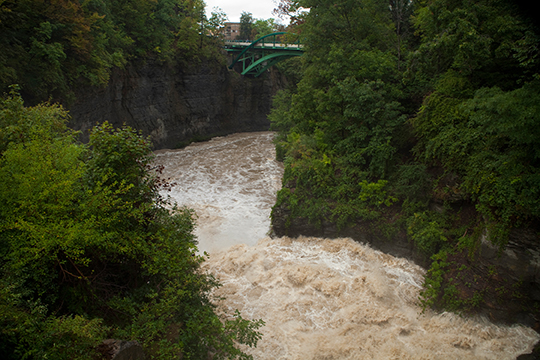
Please use caution when exploring Cornell’s gorges. The gorges and creeks surrounding Cornell are beautiful places to enjoy. However, strong undercurrents, hidden rock ledges, and debris make them unsafe places to swim.
People have been severely injured and four people have died in recent years from swimming in the gorges. Swimming is illegal in Fall Creek and Cascadilla Creek. Violators are subject to arrest. In addition, hiking off-trail presents falling concerns, a chance of rock and tree falls, and unstable gorge edges.
Seasonal Hazards
Spring – Stream currents in the gorges may be especially turbulent in the spring. Heavy rains combined with melting snow and ice often elevates creek levels. Be sure to steer clear of the water’s edge when exploring the gorge after heavy rainfall.

Summer – Hot weather makes gorge waters seem inviting areas in which to wade or swim. While the typically lower water levels these seasons often bring may appear safe, strong storms can change water levels quickly and underwater currents can still pull even strong swimmers under water. Due to these known and unpredictable hazards, swimming is prohibited in Cornell’s gorges.
Fall – As falling leaves litter the ground, trails may become slippery. Fall rainstorms can also elevate creek levels, making creek currents especially turbulent.
Winter – Snow and ice accumulate on gorge trails will cause dangerous conditions. Most gorge trails do not receive winter maintenance. Some trails, including the lower section of Cascadilla Gorge, are closed for the winter. Assess conditions on open trails before traveling on them. Additionally, the freeze thaw cycle results in numerous rock falls each year. Never travel on closed trails.
Why are there nets under the bridges?
In addition to gorge safety initiatives for recreational use, Cornell has installed horizontal nets made of tensile steel mesh underneath six bridges on and near campus and vertical mesh on a seventh (the suspension bridge).
Limiting access to this means of suicide can provide distressed individuals with time for self-destructive impulses to pass, and helps open the possibility of them receiving assistance. These means restriction systems are an important element in Cornell’s comprehensive approach to promoting mental health and preventing suicide.
